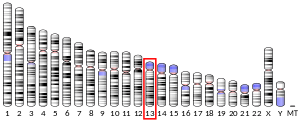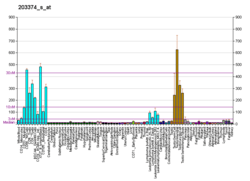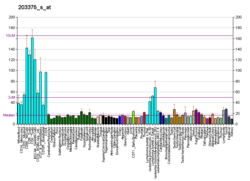Tripeptidyl peptidase II
Tripeptidyl-peptidase 2 is an enzyme that in humans is encoded by the TPP2 gene.[5][6] Among other things it is heavily implicated in MHC (HLA) class-I processing, as it has both endopeptidase and exopeptidase activity.[7]
References
- 1 2 3 GRCh38: Ensembl release 89: ENSG00000134900 - Ensembl, May 2017
- 1 2 3 GRCm38: Ensembl release 89: ENSMUSG00000041763 - Ensembl, May 2017
- ↑ "Human PubMed Reference:".
- ↑ "Mouse PubMed Reference:".
- ↑ Tomkinson B, Jonsson AK (Feb 1991). "Characterization of cDNA for human tripeptidyl peptidase II: the N-terminal part of the enzyme is similar to subtilisin". Biochemistry. 30 (1): 168–74. doi:10.1021/bi00215a025. PMID 1670990.
- ↑ "Entrez Gene: TPP2 tripeptidyl peptidase II".
- ↑ Reits E, Neijssen J, Herberts C, et al. (April 2004). "A major role for TPPII in trimming proteasomal degradation products for MHC class I antigen presentation". Immunity. 20 (4): 495–506. doi:10.1016/S1074-7613(04)00074-3. PMID 15084277.
External links
Further reading
- Tomkinson B, Zetterqvist O (1990). "Immunological cross-reactivity between human tripeptidyl peptidase II and fibronectin". Biochem. J. 267 (1): 149–54. PMC 1131257. PMID 1691635.
- Tomkinson B (1992). "Nucleotide sequence of cDNA covering the N-terminus of human tripeptidyl peptidase II". Biomed. Biochim. Acta. 50 (4–6): 727–9. PMID 1840501.
- Tomkinson B, Wernstedt C, Hellman U, Zetterqvist O (1987). "Active site of tripeptidyl peptidase II from human erythrocytes is of the subtilisin type". Proc. Natl. Acad. Sci. U.S.A. 84 (21): 7508–12. doi:10.1073/pnas.84.21.7508. PMC 299325. PMID 3313395.
- Wilson C, Gibson AM, McDermott JR (1993). "Purification and characterization of tripeptidylpeptidase-II from post-mortem human brain". Neurochem. Res. 18 (7): 743–9. doi:10.1007/BF00966768. PMID 8396212.
- Martinsson T, Vujic M, Tomkinson B (1993). "Localization of the human tripeptidyl peptidase II gene (TPP2) to 13q32-q33 by nonradioactive in situ hybridization and somatic cell hybrids". Genomics. 17 (2): 493–495. doi:10.1006/geno.1993.1353. PMID 8406500.
- Rose C, Vargas F, Facchinetti P, et al. (1996). "Characterization and inhibition of a cholecystokinin-inactivating serine peptidase". Nature. 380 (6573): 403–9. doi:10.1038/380403a0. PMID 8602240.
- Geier E, Pfeifer G, Wilm M, et al. (1999). "A giant protease with potential to substitute for some functions of the proteasome". Science. 283 (5404): 978–81. doi:10.1126/science.283.5404.978. PMID 9974389.
- Ganellin CR, Bishop PB, Bambal RB, et al. (2000). "Inhibitors of tripeptidyl peptidase II. 2. Generation of the first novel lead inhibitor of cholecystokinin-8-inactivating peptidase: a strategy for the design of peptidase inhibitors". J. Med. Chem. 43 (4): 664–74. doi:10.1021/jm990226g. PMID 10691692.
- Lévy F, Burri L, Morel S, et al. (2002). "The final N-terminal trimming of a subaminoterminal proline-containing HLA class I-restricted antigenic peptide in the cytosol is mediated by two peptidases". J. Immunol. 169 (8): 4161–71. doi:10.4049/jimmunol.169.8.4161. PMID 12370345.
- Strausberg RL, Feingold EA, Grouse LH, et al. (2003). "Generation and initial analysis of more than 15,000 full-length human and mouse cDNA sequences". Proc. Natl. Acad. Sci. U.S.A. 99 (26): 16899–903. doi:10.1073/pnas.242603899. PMC 139241. PMID 12477932.
- Ota T, Suzuki Y, Nishikawa T, et al. (2004). "Complete sequencing and characterization of 21,243 full-length human cDNAs". Nat. Genet. 36 (1): 40–5. doi:10.1038/ng1285. PMID 14702039.
- Gerhard DS, Wagner L, Feingold EA, et al. (2004). "The status, quality, and expansion of the NIH full-length cDNA project: the Mammalian Gene Collection (MGC)". Genome Res. 14 (10B): 2121–7. doi:10.1101/gr.2596504. PMC 528928. PMID 15489334.
- Lindås AC, Tomkinson B (2005). "Identification and characterization of the promoter for the gene encoding human tripeptidyl-peptidase II". Gene. 345 (2): 249–257. doi:10.1016/j.gene.2004.11.042. PMID 15716107.
- Stavropoulou V, Vasquez V, Cereser B, et al. (2006). "TPPII promotes genetic instability by allowing the escape from apoptosis of cells with activated mitotic checkpoints". Biochem. Biophys. Res. Commun. 346 (2): 415–25. doi:10.1016/j.bbrc.2006.05.141. PMID 16762321.
- York IA, Bhutani N, Zendzian S, et al. (2006). "Tripeptidyl peptidase II is the major peptidase needed to trim long antigenic precursors, but is not required for most MHC class I antigen presentation". J. Immunol. 177 (3): 1434–43. doi:10.4049/jimmunol.177.3.1434. PMID 16849449.
- Lindås AC, Tomkinson B (2007). "Characterization of the promoter of the gene encoding human tripeptidyl-peptidase II and identification of upstream silencer elements". Gene. 393 (1–2): 62–69. doi:10.1016/j.gene.2007.01.015. PMID 17343995.
This article is issued from
Wikipedia.
The text is licensed under Creative Commons - Attribution - Sharealike.
Additional terms may apply for the media files.





